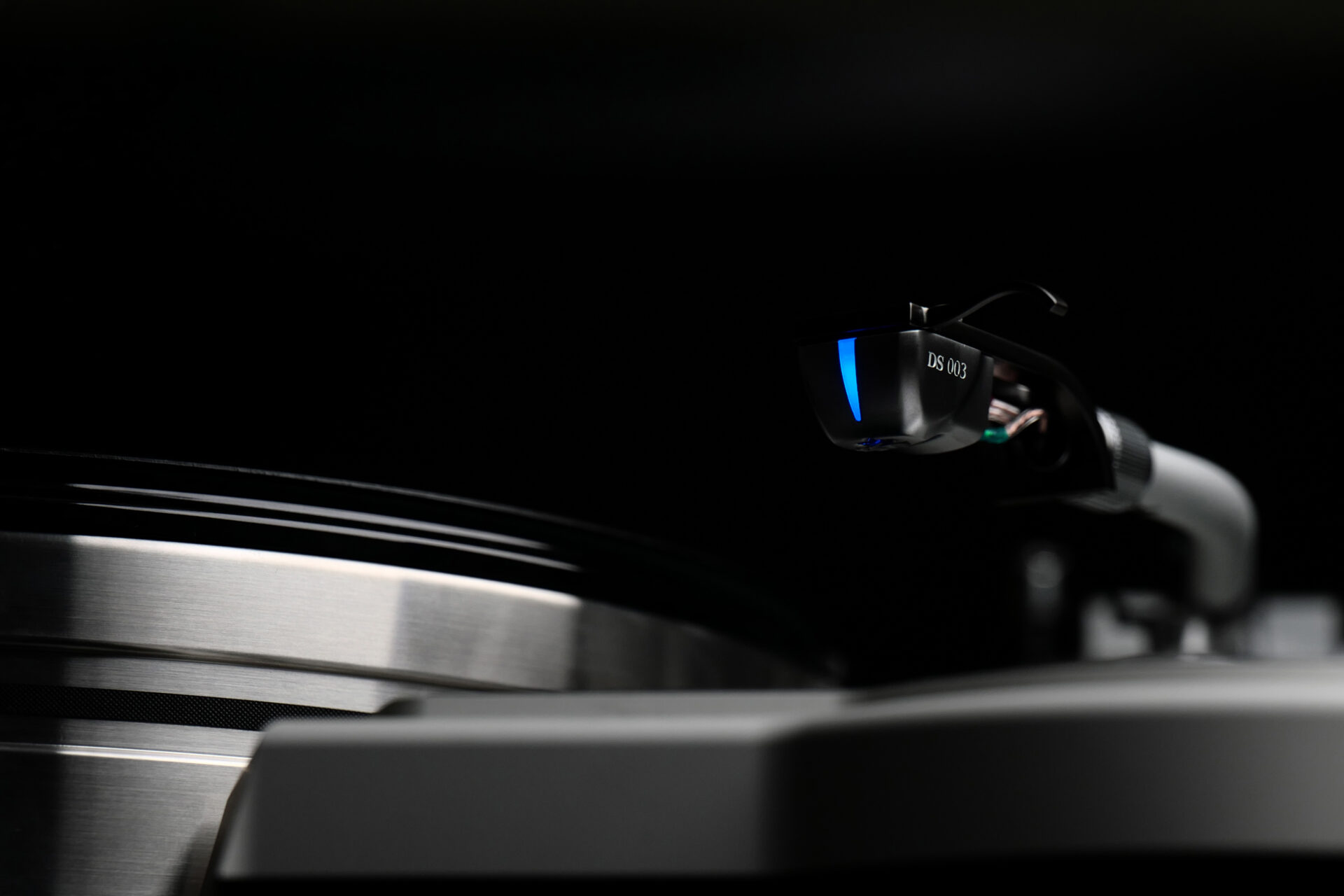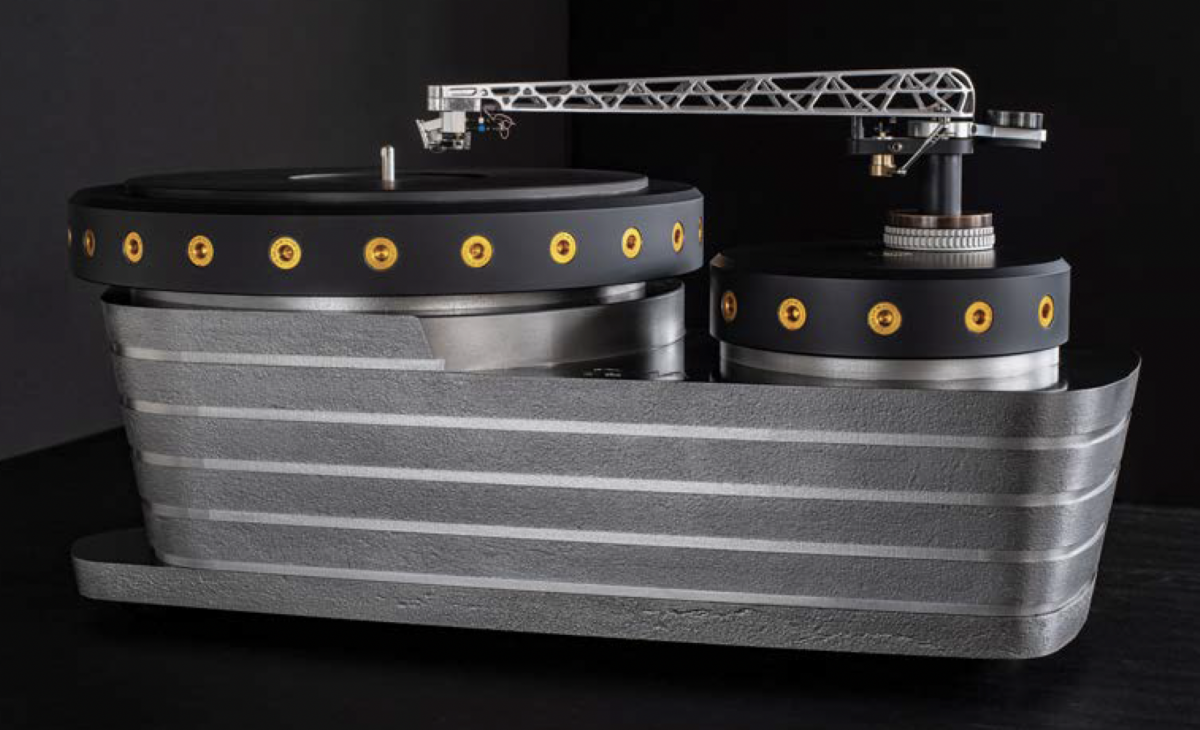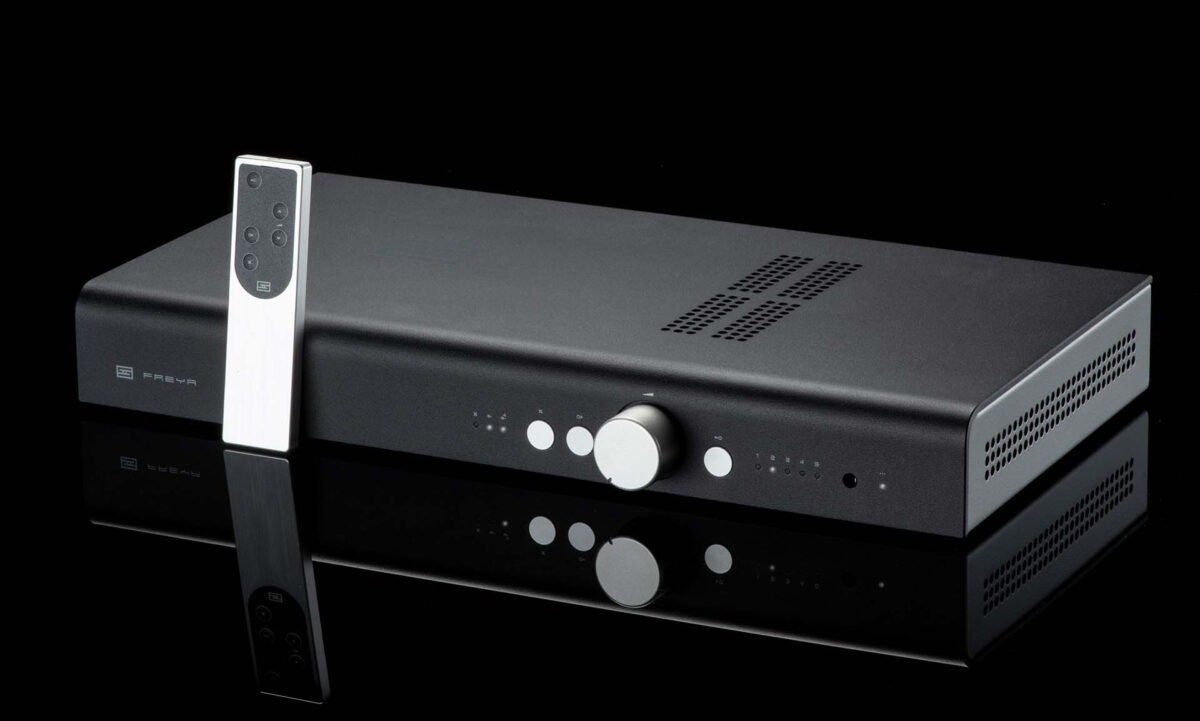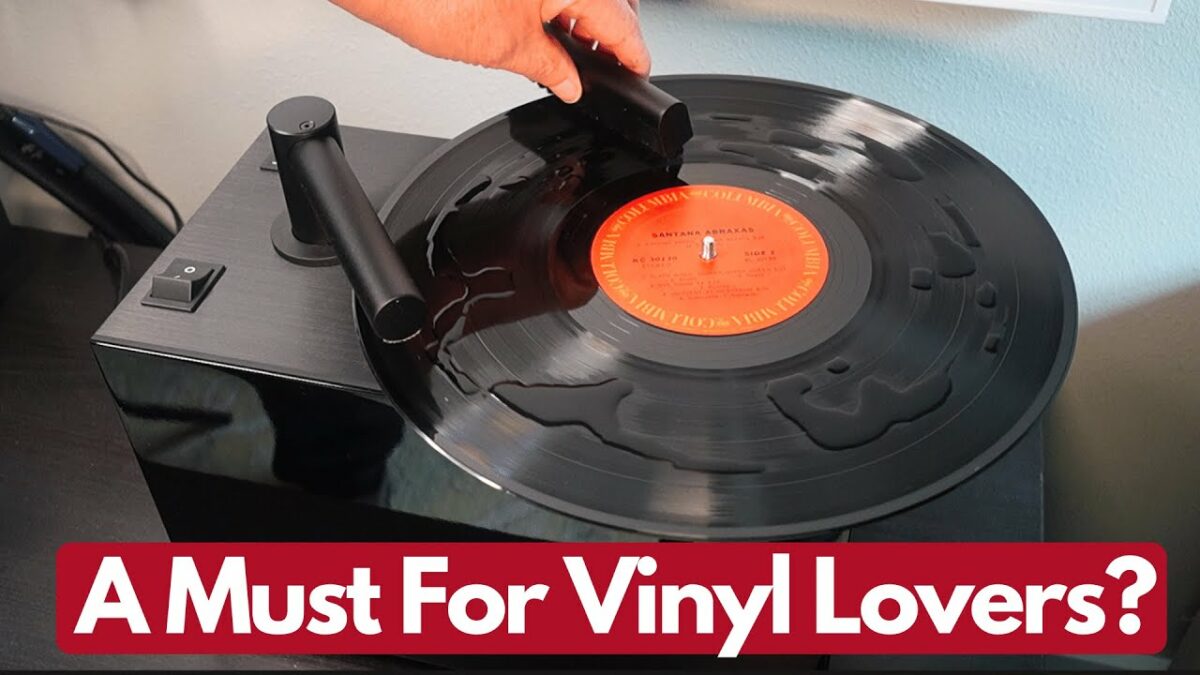
If you’ve been following my phono cartridge reviews in TAS or Ken Kessler’s in HI-Fi News & Record Review, you already know that DS Audio’s optical cartridges (oc’s) are the hottest new things in LP playback. Though the theory behind using a massless beam of light rather than comparatively massive coils or magnets to convert the movements of a stylus into electricity is not new (it dates to the 1940s), it took a latter-day technology whiz, Japan’s Tetsuaki “Aki” Aoyagi (head of DS Audio), to perfect it.
The optical groove-reading system is fairly easy to explain: The intensity of a light from a miniaturized “lamp” inside the cartridge is continuously modulated by the movement of an extremely low-mass “shading plate” attached to the stylus/cantilever. As the stylus vibrates, the shading plate vibrates in sympathy, blocking varying amounts of the light coming from the lamp. This variable luminosity is then turned into variable voltages by photoreceptors and sent on to a dedicated phonostage unit, where it is equalized and boosted to line level.
Aki’s contribution to the perfection of the optical cartridge was based on the development of the computer-era optical mouse at the Digital Stream Corporation (his father’s company). By substituting the cool-running, miniaturized LEDs and miniaturized photoreceptors found in optical mice for the hot, tiny, unreliable incandescent bulbs and bulky, low-sensitivity “electric eyes” used in previous-gen optical cartridges, he turned an unreliable twentieth-century curiosity into a wholly reliable twenty-first-century success story.
Over the years, Aki has made improvements to each successive generation of DS Audio oc, culminating (just a year ago) in his chef d’oeuvre—the fabulous and fabulously expensive Grand Master cartridge and Grand Master phonostage. What the Grand Master offered (in addition to a diamond cantilever and a micro-ridge diamond stylus) was a fundamental change in the optical “engine” itself (the first such change in DS Audio’s relatively brief history). Instead of using a single light source and photoreceptor for both channels, the Grand Master used separate ones for each channel. Coupled with the much-improved tracking and tracing of the GM’s micro-ridge stylus, this “dual-mono” optical/electrical engine raised the bar in every audible and measurable category. Channel separation (and, hence, soundstage width, depth, and height) was substantially increased, and the very low noise floor (always a huge plus with Aki’s oc’s) was lowered even further, making for the kind of silent backgrounds and abundant musical detail that you only hear on reel-to-reel analog tape—and in a concert hall, of course.
Though digital fans are used to it (or at least to a frighteningly dead, interstellar version of it), this depth of background silence is new in LP playback. As I’ve said before, we analog hounds have becomes so inured to the way in which RF audibly modulates the signal that a transducer/phonostage without RF simply must be experienced to be believed. Even then, it’s hard to fathom. It’s as if you’ve been listening to music with your window open on a noisy street. All of a sudden, the DS Audio closes the window. You just hear so much more, so much more purely and faithfully.
Thanks to the oc’s inherent rise in the bass, which, in theory, goes down to 1Hz, and absence of background racket (including the occasional AM station or passing CB), its similarity to the sound of R2R tape (which also has a robust low end and little-to-no susceptibility to RF) is far closer than what you get from conventional magnetic playback. As a result, the DS Audio Grand Master is a revelation to fidelity-to-source listeners, for whom the sound of the mastertape is the golden fleece. However, it’s also a dream come true for as-you-like-it and absolute-sound listeners, since its noise-free clarity is accompanied by rich, full, unusually deep-reaching tonality, excellent imaging and soundstaging, superb dynamic response, and the genuine illusion of real musicians making music in a real space. Indeed, the only area in which the Grand Master doesn’t challenge or equal the sound of a great tape player is in the treble, where a rise in the topmost octave makes the Grand Master a little more scintillant than tape (though it is no longer bright sounding, since the rise now begins well above the presence range, about halfway through the brilliance range).
The trouble is—or was—that to get all these great new advancements you had to buy the $15k Grand Master cartridge. (If you wanted the whole megillah, you also had to chip in another $45k for the Grand Master phonostage/equalizer.)
However, hold onto your hats (and wallets). Aki has now “trickled down” much of the Grand Master technology into one of his latest “entry-level” products—the DS 003, the subject of this review. At “only” $2500 (with another $3500 for its dedicated DS 003 phonostage/equalizer), it is not dirt cheap. But $6k is still a far cry from $60k. What do you get for one-tenth the money? Well…just about everything that makes the Grand Master the benchmark that it is.
No, you don’t get that micro-ridge stylus. You’ll just have to live with a line-contact diamond one. And you don’t get the diamond cantilever; the DS 003’s is aluminum. Though sleek, rigid, and extremely well damped, the DS 003’s body is machined from A5052 aluminum and not from the GM’s ultra-strong, ultra-light duralumin. These stylus/cantilever/chassis differences aside, however, there is not a whole lot else that separates the DS 003 cartridge from the Grand Master.
Like its ten-times more expensive brother, the DS 003 uses DS’ new “dual-mono” optical/electrical generator, with independent LEDs and photodetectors for each channel. Like the Grand Master, it uses a featherweight, 99.9% beryllium shading plate that is 50% lighter than the aluminum one used in DS Audio’s previous oc’s (prior to the Grand Master). And like the GM, the DS-Audio’s internal wiring is 1.6 times thicker than it was in first- and second-gen DSes.
These advancements make for virtually the same kind of sonic improvements that they do in the Grand Master. Because of the dual-mono setup, channel separation is greatly enhanced—to the benefit of soundstaging and imaging. (Andre Jennings measured 32dB+ channel separation at 1kHz, where the first-gen DS oc’s barely made it to 20dB.) The reduction in mass (claimed to be 1/10th that of a conventional mc cartridge) helps to improve tracking and lower noise to a near-inaudible level, increasing resolution and dynamic range. (The more-affordable first- and second-gen DSes had trouble tracking highly modulated passages on LPs and collected dust like Swiffers; the third-gen DS 003 has no such issues, tracking tough grooves and plowing through debris like a Clearaudio Goldfinger.) The better wiring and improved equalization (for which see the next paragraph) helps render tonality in the same lusciously rich, full-bodied, deep-reaching fashion that you hear on the GM, with tape, and in life.
Like the Grand Master unit, the DS 003’s companion phonostage/equalizer benefits from thicker circuit boards (increased from 1.6mm to 2.0mm) and denser copper-foil traces (up from 35μ to 70μ). Of course, the compact DS 003 phonostage is not nearly as large, complex, and state of the art as the two-chassis Grand Master one. Though it does provide four different roll-off curves for the low frequencies (the GM has six), it doesn’t have the flexibility, power-supply storage capacitance, channel separation, S/N ratio, etc. of the pricey GM. As a result, the sound of the cartridge played back through it is just a little less firmly controlled in the low end, finely resolved in the midband, vast in staging, and tape-like smooth top to bottom. (If you run the DS 003 through the Grand Master phonostage, as I did for an experiment, you will see that the primary sonic difference-maker here is the DS 003 equalizer, not the cartridge itself.) Ten times more dollars better buy you something, and it does in the DS Audio line, though the extent of improvement which that added investment makes will depend, to a degree, on the transparency of your speakers, amplification, and turntable.
It is now time for the traditional “and then I listened to” portion of the review (see sidebar). However, in this case it’s not really necessary, as the virtues of the DS 003 can be summed up in a few words. To wit, no, the DS 003 duo (cartridge/phonostage) is not the equal of the Grand Master duo (particularly the phonostage), but it comes so close to the beautiful, transparent, spacious, noise-less, dynamic, uncannily tape-like (which is to say, uncannily lifelike) sound of that paragon—on any recording of any kind of music—that I would be hard put to recommend the Grand Master ahead of it for most listeners.
If you have a system that is capable of highest-resolution playback, then by all means go whole hog and get the Grand Master set. You won’t regret it. But if you don’t have Magico M9s or Wilson Chronosonic XVXes or Stenheim References or Estelon Forzas or MBL 101 X-tremes or Maggie 30.7s—and you’re not equipped with a Walker Audio Proscenium, Acoustic Signature Invictus Neo, Basis Transcendence, TechDAS Air Force Zero, or top-line Soulution, Constellation, Pilium, CH Precision, Zanden, Air Tight, etc. amplification (with appropriate cabling and interconnect, of course)—then the choice is easy: Go for the DS 003. Maybe even if you do have these goodies, you’d want to think about it. This is just a marvelous transducer. It will certainly be my nominee for TAS Phono Cartridge of the Year.
Specs & Pricing
DS 003 Optical Cartridge
Signal output: Photo-electric conversion
Channel separation: 27dB + (1kHz)
Weight: 7.7g
Output signal level: 70mV (1kHz)
Cantilever: Aluminum
Stylus: Line contact
Body material: Aluminum (A5052)
Cantilever holder material: Stainless
Tracking force: 2.0g–2.2g (2.1g recommended)
Price: $2500
DS 003 Phonostage
Output voltage: 500mV (1kHz Equalizer output)
Output impedance: RCA 120 ohms
Preamp input impedance: > 10k ohms
Input terminal: RCA
Output terminal: RCA x2
Dimensions: 33cm x 9.2cm x 29.5cm
Weight: 5.0kg
Price: $3500
MUSICAL SURROUNDINGS (U.S. Distributor)
(510) 547-5006
info@musicalsurroundings.com
JV’s Reference System
Loudspeakers: MBL 101 X-treme, Stenheim Alumine Five SE, Estelon X Diamond Mk II, Magico M3, Voxativ 9.87, Avantgarde Zero 1, Magnepan LRS+, 1.7, and 30.7
Subwoofers: JL Audio Gotham (pair)
Linestage preamps: Soulution 725, MBL 6010 D, Constellation Audio Altair II, Siltech SAGA System C1, Air Tight ATE-2001 Reference, Zanden 3100
Phonostage preamps: Soulution 755, Constellation Audio Perseus, DS Audio Grand Master
Power amplifiers: Soulution 711, MBL 9008 A, Aavik P-580, Constellation Audio Hercules II Stereo, Air Tight 3211, Air Tight ATM-2001, Zanden Audio Systems Model 9600, Siltech SAGA System V1/P1, Odyssey Audio Stratos, Voxativ Integrated 805
Analog source: Clearaudio Master Innovation, Acoustic Signature Invictus Jr./T-9000, Walker Audio Proscenium Black Diamond Mk V, TW Acustic Black Knight/TW Raven 10.5, AMG Viella 12
Tape deck: Metaxas & Sins Tourbillon T-RX, United Home Audio Ultimate 4 OPS
Phono cartridges: DS Audio Grandmaster, DS Audio Master1, DS Audio DS 003 Clearaudio Goldfinger Statement, Air Tight Opus 1, Ortofon MC Anna, Ortofon MC A90
Digital source: MSB Reference DAC, Soulution 760, Berkeley Alpha DAC 2
Cable and interconnect: CrystalConnect Art Series Da Vinci, Crystal Cable Ultimate Dream, Synergistic Research SRX, Ansuz Acoustics Diamond
Power cords: CrystalConnect Art Series Da Vinci, Crystal Cable Ultimate Dream, Synergistic Research SRX, Ansuz Acoustics Diamond
Power conditioner: AudioQuest Niagara 5000 (two), Synergistic Research Galileo UEF, Ansuz Acoustics DTC, Technical Brain
Support systems: Critical Mass Systems MAXXUM and QXK equipment racks and amp stands and Center- Stage2M footers
Room Treatments: Stein Music H2 Harmonizer system, Synergistic Research UEF Acoustic Panels/Atmosphere XL4/UEF Acoustic Dot system, Synergistic Research ART system, Shakti Hallographs (6), Zanden Acoustic panels, A/V Room Services Metu acoustic panels and traps, ASC Tube Traps
Accessories: DS Audio ION-001, SteinMusic Pi Carbon Signature record mat, Symposium Isis and Ultra equipment platforms, Symposium Rollerblocks and Fat Padz, Walker Prologue Reference equipment and amp stands, Walker Valid Points and Resonance Control discs, Clearaudio Double Matrix Professional Sonic record cleaner, Synergistic Research RED Quantum fuses, HiFi-Tuning silver/gold fuses

By Jonathan Valin
I’ve been a creative writer for most of life. Throughout the 80s and 90s, I wrote eleven novels and many stories—some of which were nominated for (and won) prizes, one of which was made into a not-very-good movie by Paramount, and all of which are still available hardbound and via download on Amazon. At the same time I taught creative writing at a couple of universities and worked brief stints in Hollywood. It looked as if teaching and writing more novels, stories, reviews, and scripts was going to be my life. Then HP called me up out of the blue, and everything changed. I’ve told this story several times, but it’s worth repeating because the second half of my life hinged on it. I’d been an audiophile since I was in my mid-teens, and did all the things a young audiophile did back then, buying what I could afford (mainly on the used market), hanging with audiophile friends almost exclusively, and poring over J. Gordon Holt’s Stereophile and Harry Pearson’s Absolute Sound. Come the early 90s, I took a year and a half off from writing my next novel and, music lover that I was, researched and wrote a book (now out of print) about my favorite classical records on the RCA label. Somehow Harry found out about that book (The RCA Bible), got my phone number (which was unlisted, so to this day I don’t know how he unearthed it), and called. Since I’d been reading him since I was a kid, I was shocked. “I feel like I’m talking to God,” I told him. “No,” said he, in that deep rumbling voice of his, “God is talking to you.” I laughed, of course. But in a way it worked out to be true, since from almost that moment forward I’ve devoted my life to writing about audio and music—first for Harry at TAS, then for Fi (the magazine I founded alongside Wayne Garcia), and in the new millennium at TAS again, when HP hired me back after Fi folded. It’s been an odd and, for the most part, serendipitous career, in which things have simply come my way, like Harry’s phone call, without me planning for them. For better and worse I’ve just gone with them on instinct and my talent to spin words, which is as close to being musical as I come.
More articles from this editorRead Next From Review
See all
Oswalds Mill Audio K3 Turntable
- Apr 12, 2024

2023 Golden Ear: Schiit Freya S Preamplifier
- Apr 12, 2024




















